Compressor belt SUZUKI SWIFT 2008 2.G Service User Guide
[x] Cancel search | Manufacturer: SUZUKI, Model Year: 2008, Model line: SWIFT, Model: SUZUKI SWIFT 2008 2.GPages: 1496, PDF Size: 34.44 MB
Page 956 of 1496
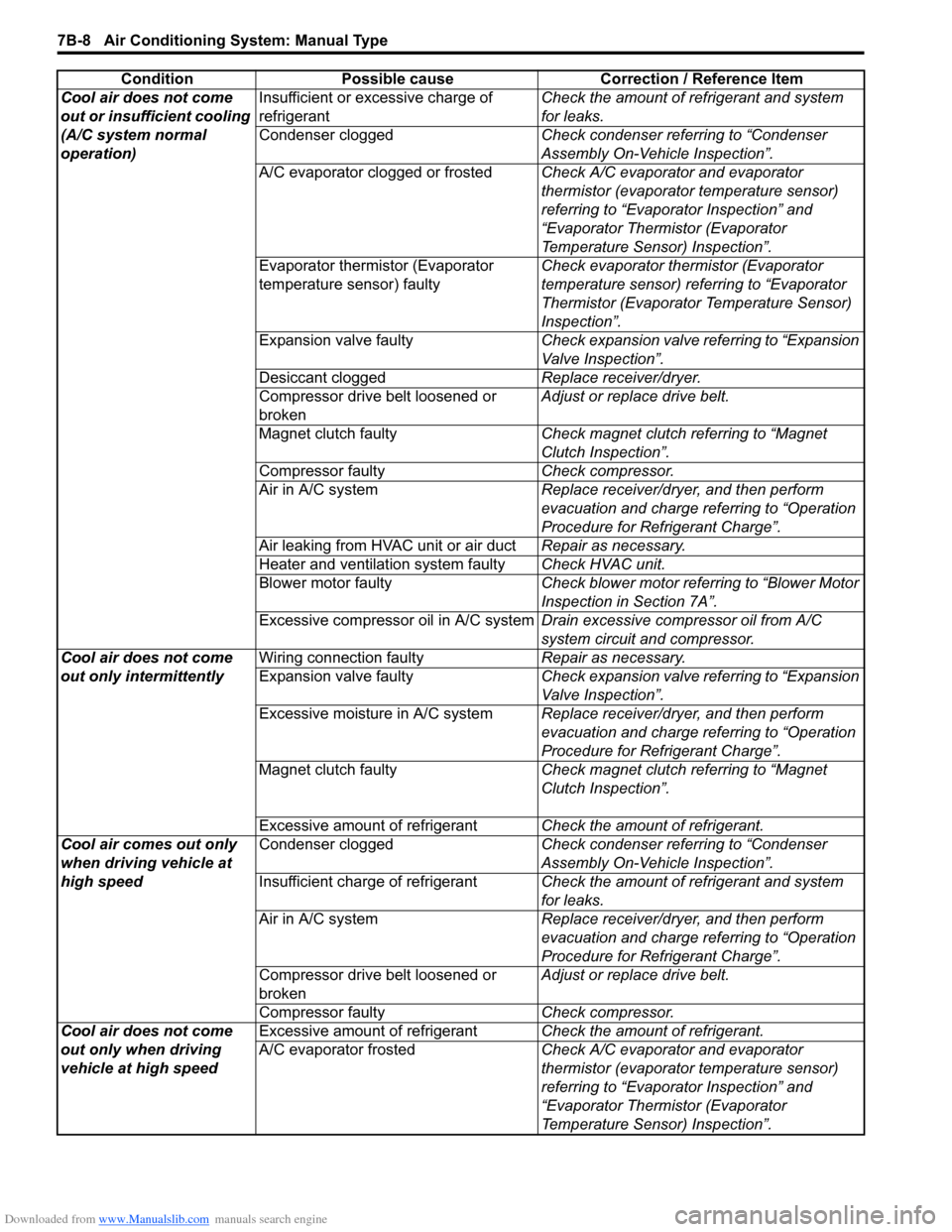
Downloaded from www.Manualslib.com manuals search engine 7B-8 Air Conditioning System: Manual Type
Cool air does not come
out or insufficient cooling
(A/C system normal
operation)Insufficient or excessive charge of
refrigerant
Check the amount of refrigerant and system
for leaks.
Condenser clogged Check condenser referring to тАЬCondenser
Assembly On-Vehicle InspectionтАЭ.
A/C evaporator clogged or frosted Check A/C evaporator and evaporator
thermistor (evaporator temperature sensor)
referring to тАЬEvaporator InspectionтАЭ and
тАЬEvaporator Thermistor (Evaporator
Temperature Sensor) InspectionтАЭ.
Evaporator thermistor (Evaporator
temperature sensor) faulty Check evaporator thermistor (Evaporator
temperature sensor) referring to тАЬEvaporator
Thermistor (Evaporator Temperature Sensor)
InspectionтАЭ.
Expansion valve faulty Check expansion valve referring to тАЬExpansion
Valve InspectionтАЭ.
Desiccant clogged Replace receiver/dryer.
Compressor drive belt loosened or
broken Adjust or replace drive belt.
Magnet clutch faulty Check magnet clutch referring to тАЬMagnet
Clutch InspectionтАЭ.
Compressor faulty Check compressor.
Air in A/C system Replace receiver/dryer, and then perform
evacuation and charge referring to тАЬOperation
Procedure for Refrigerant ChargeтАЭ.
Air leaking from HVAC unit or air duct Repair as necessary.
Heater and ventilation system faulty Check HVAC unit.
Blower motor faulty Check blower motor referring to тАЬBlower Motor
Inspection in Section 7AтАЭ.
Excessive compressor oil in A/C system Drain excessive compressor oil from A/C
system circuit and compressor.
Cool air does not come
out only intermittently Wiring connection faulty
Repair as necessary.
Expansion valve faulty Check expansion valve referring to тАЬExpansion
Valve InspectionтАЭ.
Excessive moisture in A/C system Replace receiver/dryer, and then perform
evacuation and charge referring to тАЬOperation
Procedure for Refrigerant ChargeтАЭ.
Magnet clutch faulty Check magnet clutch referring to тАЬMagnet
Clutch InspectionтАЭ.
Excessive amount of refrigerant Check the amount of refrigerant.
Cool air comes out only
when driving vehicle at
high speed Condenser clogged
Check condenser referring to тАЬCondenser
Assembly On-Vehicle InspectionтАЭ.
Insufficient charge of refrigerant Check the amount of refrigerant and system
for leaks.
Air in A/C system Replace receiver/dryer, and then perform
evacuation and charge referring to тАЬOperation
Procedure for Refrigerant ChargeтАЭ.
Compressor drive belt loosened or
broken Adjust or replace drive belt.
Compressor faulty Check compressor.
Cool air does not come
out only when driving
vehicle at high speed Excessive amount of refrigerant
Check the amount of refrigerant.
A/C evaporator frosted Check A/C evaporator and evaporator
thermistor (evaporator temperature sensor)
referring to тАЬEvaporator InspectionтАЭ and
тАЬEvaporator Thermistor (Evaporator
Temperature Sensor) InspectionтАЭ.
Condition Possible cause Correction / Reference Item
Page 957 of 1496
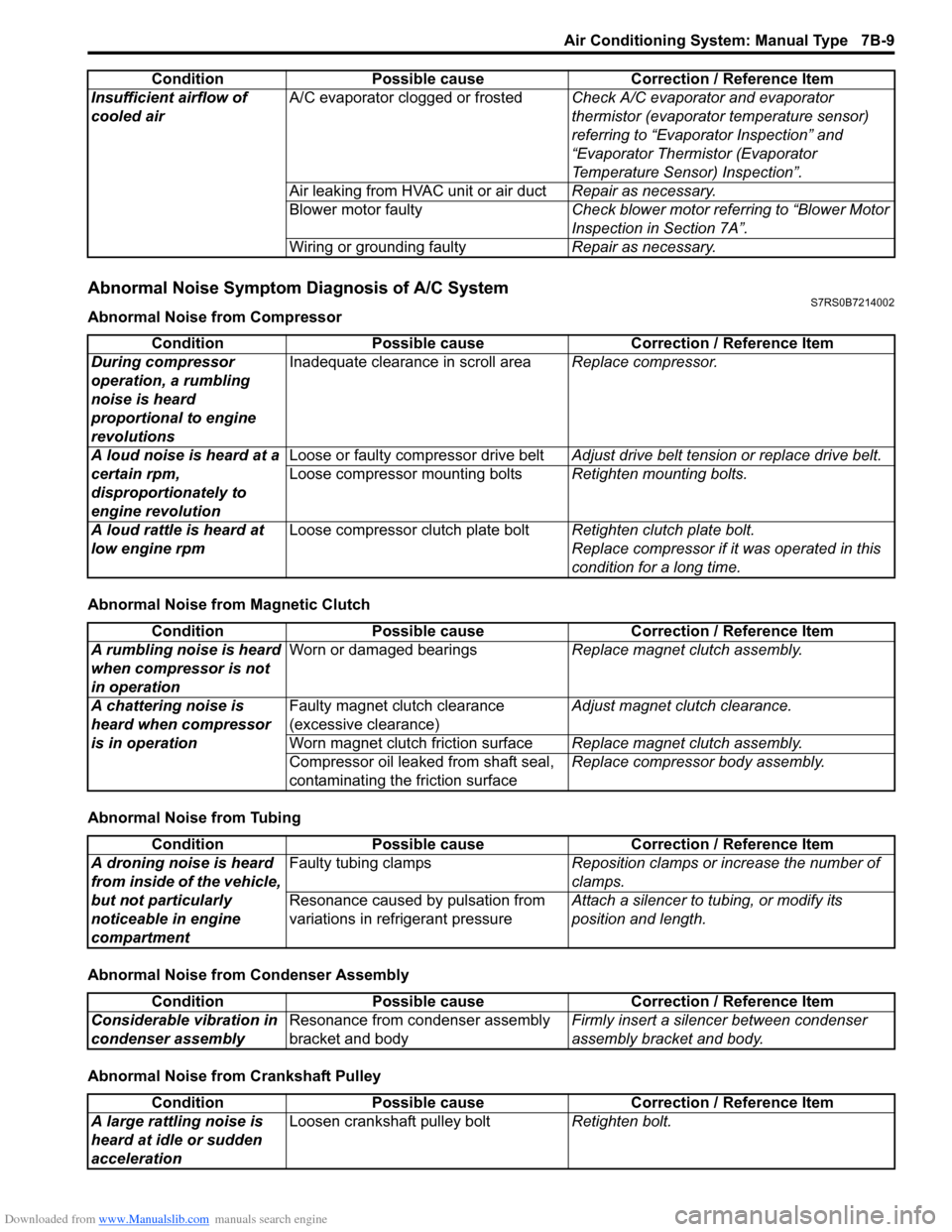
Downloaded from www.Manualslib.com manuals search engine Air Conditioning System: Manual Type 7B-9
Abnormal Noise Symptom Diagnosis of A/C SystemS7RS0B7214002
Abnormal Noise from Compressor
Abnormal Noise from Magnetic Clutch
Abnormal Noise from Tubing
Abnormal Noise from Condenser Assembly
Abnormal Noise from Crankshaft PulleyInsufficient airflow of
cooled air
A/C evaporator clogged or frosted
Check A/C evaporator and evaporator
thermistor (evaporator temperature sensor)
referring to тАЬEvaporator InspectionтАЭ and
тАЬEvaporator Thermistor (Evaporator
Temperature Sensor) InspectionтАЭ.
Air leaking from HVAC unit or air duct Repair as necessary.
Blower motor faulty Check blower motor referring to тАЬBlower Motor
Inspection in Section 7AтАЭ.
Wiring or grounding faulty Repair as necessary.
Condition Possible cause Correction / Reference Item
Condition
Possible cause Correction / Reference Item
During compressor
operation, a rumbling
noise is heard
proportional to engine
revolutions Inadequate clearance in scroll area
Replace compressor.
A loud noise is heard at a
certain rpm,
disproportionately to
engine revolution Loose or faulty compressor drive belt
Adjust drive belt tension or replace drive belt.
Loose compressor mounting bolts Retighten mounting bolts.
A loud rattle is heard at
low engine rpm Loose compressor clutch plate bolt
Retighten clutch plate bolt.
Replace compressor if it was operated in this
condition for a long time.
Condition Possible cause Correction / Reference Item
A rumbling noise is heard
when compressor is not
in operation Worn or damaged bearings
Replace magnet clutch assembly.
A chattering noise is
heard when compressor
is in operation Faulty magnet clutch clearance
(excessive clearance)
Adjust magnet clutch clearance.
Worn magnet clutch friction surface Replace magnet clutch assembly.
Compressor oil leaked from shaft seal,
contaminating the friction surface Replace compressor body assembly.
Condition
Possible cause Correction / Reference Item
A droning noise is heard
from inside of the vehicle,
but not particularly
noticeable in engine
compartment Faulty tubing clamps
Reposition clamps or increase the number of
clamps.
Resonance caused by pulsation from
variations in re frigerant pressure Attach a silencer to tubing, or modify its
position and length.
Condition
Possible cause Correction / Reference Item
Considerable vibration in
condenser assembly Resonance from condenser assembly
bracket and body Firmly insert a silenc
er between condenser
assembly bracket and body.
Condition Possible cause Correction / Reference Item
A large rattling noise is
heard at idle or sudden
acceleration Loosen crankshaft pulley bolt
Retighten bolt.
Page 975 of 1496
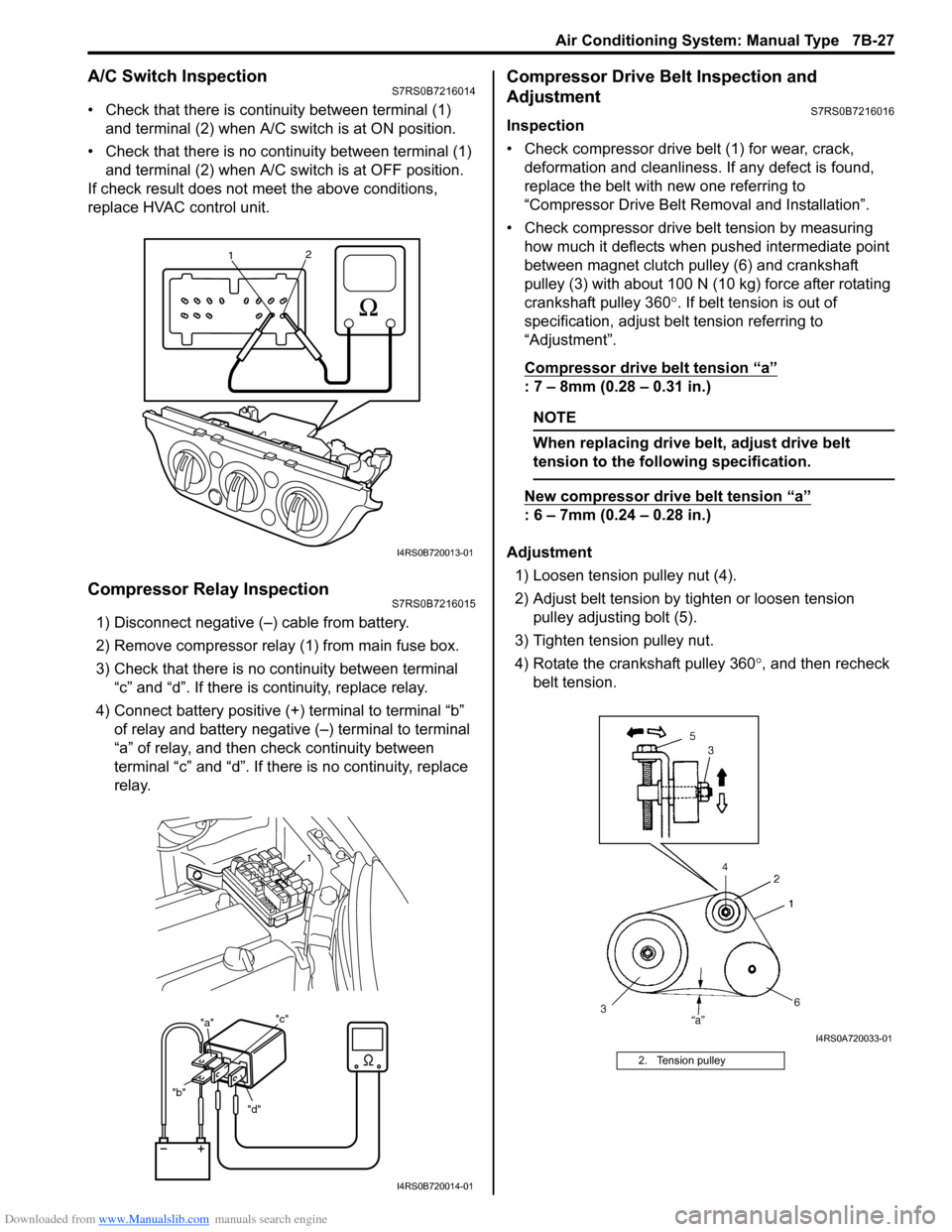
Downloaded from www.Manualslib.com manuals search engine Air Conditioning System: Manual Type 7B-27
A/C Switch InspectionS7RS0B7216014
тАв Check that there is continuity between terminal (1) and terminal (2) when A/C s witch is at ON position.
тАв Check that there is no continuity between terminal (1) and terminal (2) when A/C s witch is at OFF position.
If check result does not meet the above conditions,
replace HVAC control unit.
Compressor Relay InspectionS7RS0B7216015
1) Disconnect negative (тАУ) cable from battery.
2) Remove compressor relay (1) from main fuse box.
3) Check that there is no continuity between terminal тАЬcтАЭ and тАЬdтАЭ. If there is continuity, replace relay.
4) Connect battery positive (+ ) terminal to terminal тАЬbтАЭ
of relay and battery negative (тАУ) terminal to terminal
тАЬaтАЭ of relay, and then check continuity between
terminal тАЬcтАЭ and тАЬdтАЭ. If there is no continuity, replace
relay.
Compressor Drive Belt Inspection and
Adjustment
S7RS0B7216016
Inspection
тАв Check compressor drive belt (1) for wear, crack, deformation and cleanliness. If any defect is found,
replace the belt with new one referring to
тАЬCompressor Drive Belt Re moval and InstallationтАЭ.
тАв Check compressor drive belt tension by measuring how much it deflects when pushed intermediate point
between magnet clutch pulley (6) and crankshaft
pulley (3) with about 100 N (10 kg) force after rotating
crankshaft pulley 360 ┬░. If belt tension is out of
specification, adjust belt tension referring to
тАЬAdjustmentтАЭ.
Compressor drive belt tension
тАЬaтАЭ
: 7 тАУ 8mm (0.28 тАУ 0.31 in.)
NOTE
When replacing drive belt, adjust drive belt
tension to the following specification.
New compressor dr ive belt tension тАЬaтАЭ
: 6 тАУ 7mm (0.24 тАУ 0.28 in.)
Adjustment 1) Loosen tension pulley nut (4).
2) Adjust belt tension by ti ghten or loosen tension
pulley adjusting bolt (5).
3) Tighten tension pulley nut.
4) Rotate the crankshaft pulley 360 ┬░, and then recheck
belt tension.
1 2
I4RS0B720013-01
"d"
"b" "a"
"c"
1
I4RS0B720014-01
2. Tension pulley
I4RS0A720033-01
Page 976 of 1496
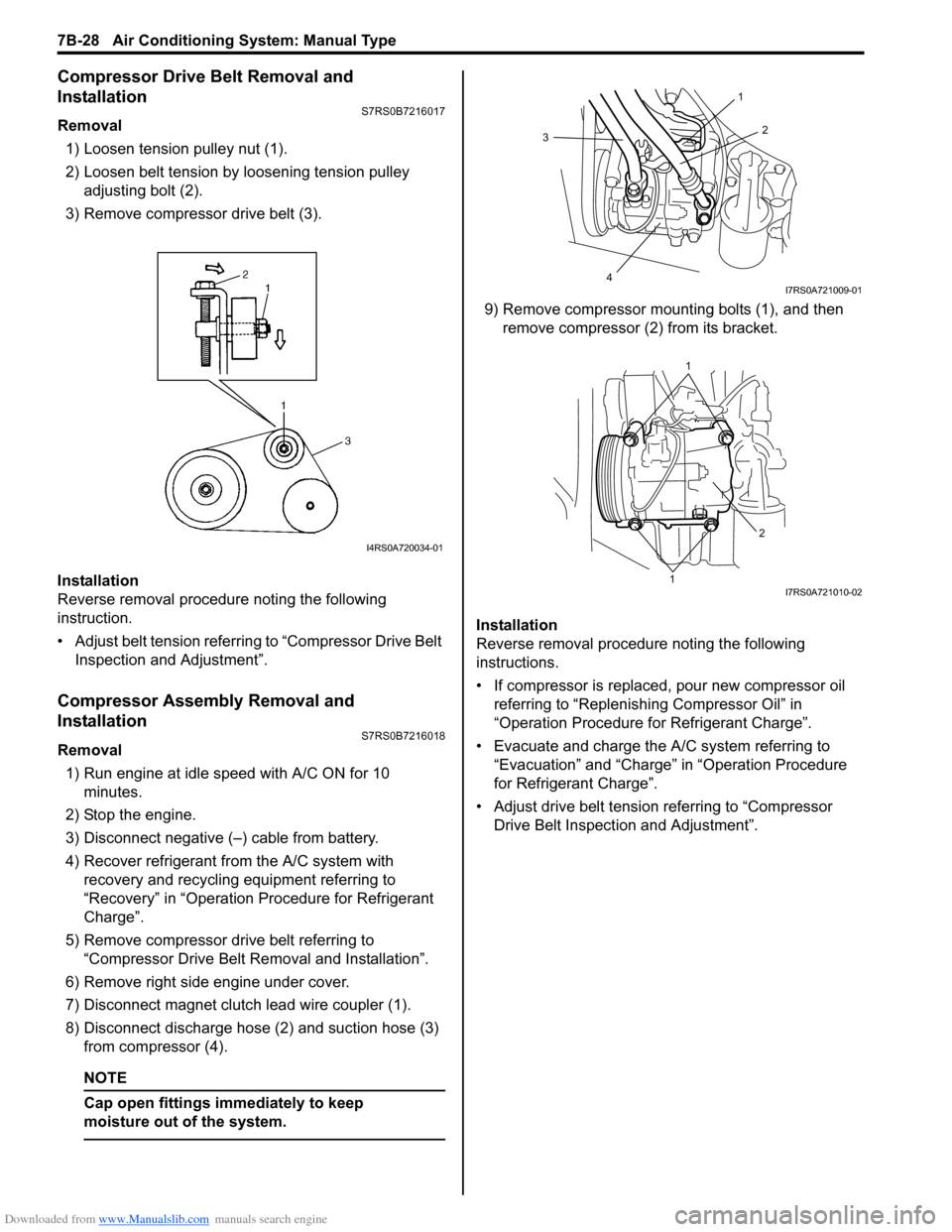
Downloaded from www.Manualslib.com manuals search engine 7B-28 Air Conditioning System: Manual Type
Compressor Drive Belt Removal and
Installation
S7RS0B7216017
Removal1) Loosen tension pulley nut (1).
2) Loosen belt tension by loosening tension pulley adjusting bolt (2).
3) Remove compressor drive belt (3).
Installation
Reverse removal procedure noting the following
instruction.
тАв Adjust belt tension referring to тАЬCompressor Drive Belt Inspection and AdjustmentтАЭ.
Compressor Assembly Removal and
Installation
S7RS0B7216018
Removal
1) Run engine at idle speed with A/C ON for 10 minutes.
2) Stop the engine.
3) Disconnect negative (тАУ) cable from battery.
4) Recover refrigerant fr om the A/C system with
recovery and recycling equipment referring to
тАЬRecoveryтАЭ in тАЬOperation Procedure for Refrigerant
ChargeтАЭ.
5) Remove compressor drive belt referring to тАЬCompressor Drive Belt Re moval and InstallationтАЭ.
6) Remove right side engine under cover.
7) Disconnect magnet clutch lead wire coupler (1).
8) Disconnect discharge hose (2) and suction hose (3) from compressor (4).
NOTE
Cap open fittings immediately to keep
moisture out of the system.
9) Remove compressor mounting bolts (1), and then remove compressor (2 ) from its bracket.
Installation
Reverse removal procedure noting the following
instructions.
тАв If compressor is replaced, pour new compressor oil referring to тАЬReplenishi ng Compressor OilтАЭ in
тАЬOperation Procedure for Refrigerant ChargeтАЭ.
тАв Evacuate and charge the A/C system referring to тАЬEvacuationтАЭ and тАЬChargeтАЭ in тАЬOperation Procedure
for Refrigerant ChargeтАЭ.
тАв Adjust drive belt tension referring to тАЬCompressor Drive Belt Inspecti on and AdjustmentтАЭ.
I4RS0A720034-01
3
4 2
1
I7RS0A721009-01
1
1 2
I7RS0A721010-02
Page 987 of 1496
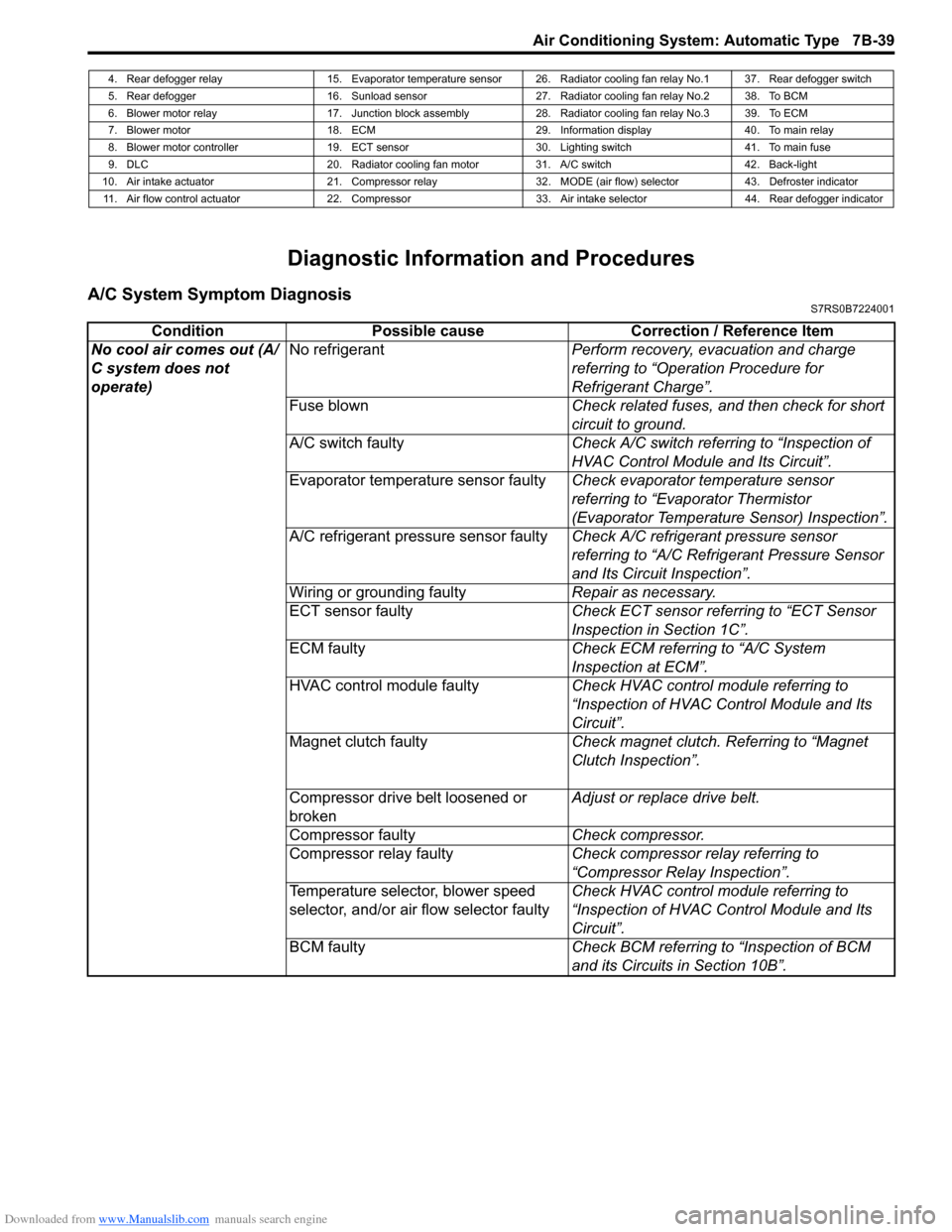
Downloaded from www.Manualslib.com manuals search engine Air Conditioning System: Automatic Type 7B-39
Diagnostic Information and Procedures
A/C System Symptom DiagnosisS7RS0B7224001
4. Rear defogger relay 15. Evaporator temperature sensor 26. Radiator cooling fan relay No.1 37. Rear defogger switch
5. Rear defogger 16. Sunload sensor 27. Radiator cooling fan relay No.2 38. To BCM
6. Blower motor relay 17. Junction block assembly 28. Radiator cooling fan relay No.3 39. To ECM
7. Blower motor 18. ECM 29. Information display 40. To main relay
8. Blower motor controller 19. ECT sensor 30. Lighting switch 41. To main fuse
9. DLC 20. Radiator cooling fan motor 31. A/C switch 42. Back-light
10. Air intake actuator 21. Compressor relay 32. MODE (air flow) selector 43. Defroster indicator 11. Air flow control actuator 22. Compressor 33. Air intake selector 44. Rear defogger indicator
Condition Possible cause Correction / Reference Item
No cool air comes out (A/
C system does not
operate) No refrigerant
Perform recovery, evacuation and charge
referring to тАЬOperation Procedure for
Refrigerant ChargeтАЭ.
Fuse blown Check related fuses, and then check for short
circuit to ground.
A/C switch faulty Check A/C switch referring to тАЬInspection of
HVAC Control Module and Its CircuitтАЭ.
Evaporator temperature sensor faulty Check evaporator temperature sensor
referring to тАЬEvaporator Thermistor
(Evaporator Temperature Sensor) InspectionтАЭ.
A/C refrigerant pressure sensor faulty Check A/C refrigerant pressure sensor
referring to тАЬA/C Refrigerant Pressure Sensor
and Its Circuit InspectionтАЭ.
Wiring or grounding faulty Repair as necessary.
ECT sensor faulty Check ECT sensor referring to тАЬECT Sensor
Inspection in Section 1CтАЭ.
ECM faulty Check ECM referring to тАЬA/C System
Inspection at ECMтАЭ.
HVAC control module faulty Check HVAC control module referring to
тАЬInspection of HVAC Control Module and Its
CircuitтАЭ.
Magnet clutch faulty Check magnet clutch. Referring to тАЬMagnet
Clutch InspectionтАЭ.
Compressor drive belt loosened or
broken Adjust or replace drive belt.
Compressor faulty Check compressor.
Compressor relay faulty Check compressor relay referring to
тАЬCompressor Relay InspectionтАЭ.
Temperature selector, blower speed
selector, and/or air flow selector faulty Check HVAC control module referring to
тАЬInspection of HVAC Control Module and Its
CircuitтАЭ.
BCM faulty Check BCM referring to тАЬInspection of BCM
and its Circuits in Section 10BтАЭ.
Page 989 of 1496
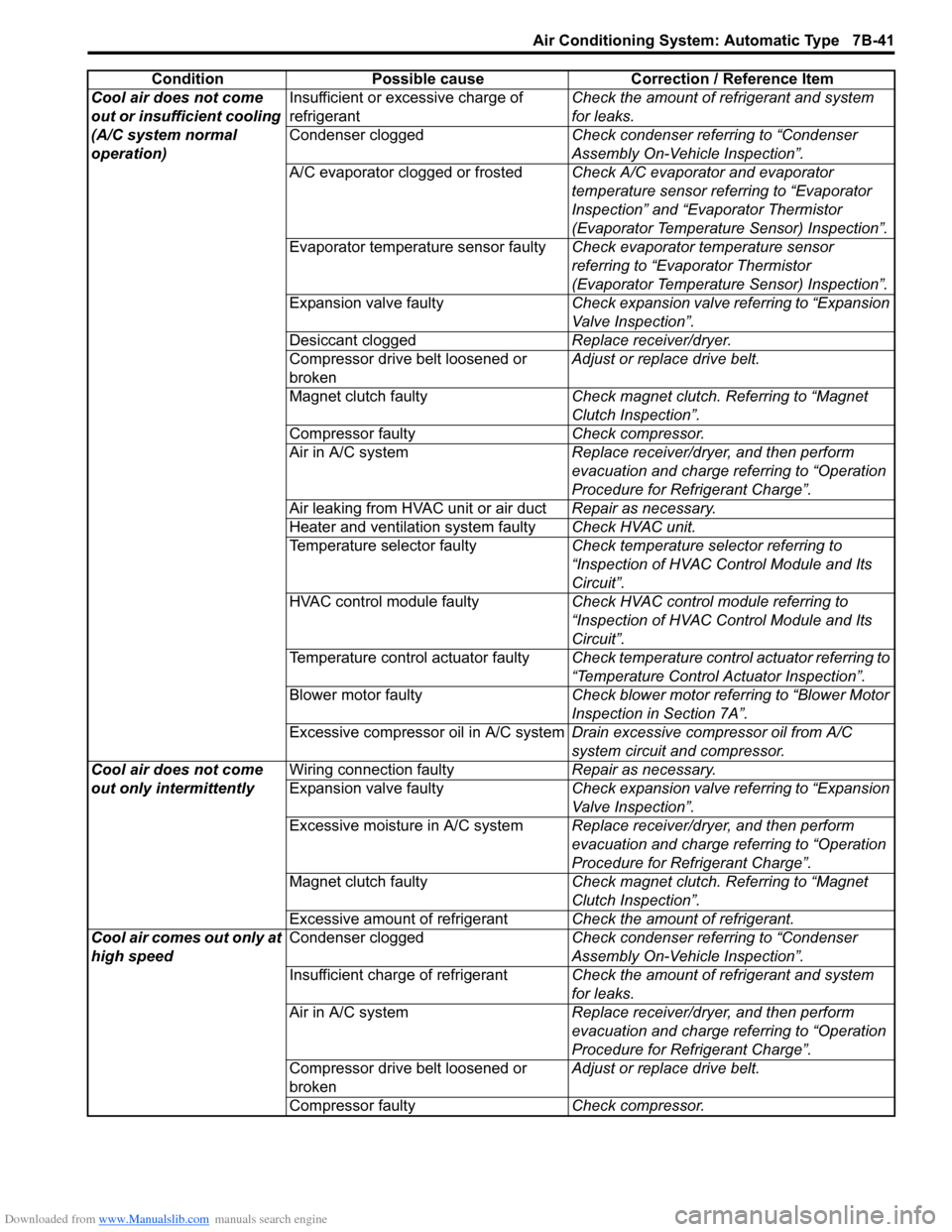
Downloaded from www.Manualslib.com manuals search engine Air Conditioning System: Automatic Type 7B-41
Cool air does not come
out or insufficient cooling
(A/C system normal
operation)Insufficient or excessive charge of
refrigerant
Check the amount of refrigerant and system
for leaks.
Condenser clogged Check condenser referring to тАЬCondenser
Assembly On-Vehicle InspectionтАЭ.
A/C evaporator clogged or frosted Check A/C evaporator and evaporator
temperature sensor referring to тАЬEvaporator
InspectionтАЭ and тАЬEvaporator Thermistor
(Evaporator Temperature Sensor) InspectionтАЭ.
Evaporator temperature sensor faulty Check evaporator temperature sensor
referring to тАЬEvaporator Thermistor
(Evaporator Temperature Sensor) InspectionтАЭ.
Expansion valve faulty Check expansion valve referring to тАЬExpansion
Valve InspectionтАЭ.
Desiccant clogged Replace receiver/dryer.
Compressor drive belt loosened or
broken Adjust or replace drive belt.
Magnet clutch faulty Check magnet clutch. Referring to тАЬMagnet
Clutch InspectionтАЭ.
Compressor faulty Check compressor.
Air in A/C system Replace receiver/dryer, and then perform
evacuation and charge referring to тАЬOperation
Procedure for Refrigerant ChargeтАЭ.
Air leaking from HVAC unit or air duct Repair as necessary.
Heater and ventilation system faulty Check HVAC unit.
Temperature selector faulty Check temperature selector referring to
тАЬInspection of HVAC Control Module and Its
CircuitтАЭ.
HVAC control module faulty Check HVAC control module referring to
тАЬInspection of HVAC Control Module and Its
CircuitтАЭ.
Temperature control actuator faulty Check temperature control actuator referring to
тАЬTemperature Control Actuator InspectionтАЭ.
Blower motor faulty Check blower motor referring to тАЬBlower Motor
Inspection in Section 7AтАЭ.
Excessive compressor oil in A/C system Drain excessive compressor oil from A/C
system circuit and compressor.
Cool air does not come
out only intermittently Wiring connection faulty
Repair as necessary.
Expansion valve faulty Check expansion valve referring to тАЬExpansion
Valve InspectionтАЭ.
Excessive moisture in A/C system Replace receiver/dryer, and then perform
evacuation and charge referring to тАЬOperation
Procedure for Refrigerant ChargeтАЭ.
Magnet clutch faulty Check magnet clutch. Referring to тАЬMagnet
Clutch InspectionтАЭ.
Excessive amount of refrigerant Check the amount of refrigerant.
Cool air comes out only at
high speed Condenser clogged
Check condenser referring to тАЬCondenser
Assembly On-Vehicle InspectionтАЭ.
Insufficient charge of refrigerant Check the amount of refrigerant and system
for leaks.
Air in A/C system Replace receiver/dryer, and then perform
evacuation and charge referring to тАЬOperation
Procedure for Refrigerant ChargeтАЭ.
Compressor drive belt loosened or
broken Adjust or replace drive belt.
Compressor faulty Check compressor.
Condition Possible cause Correction / Reference Item
Page 997 of 1496
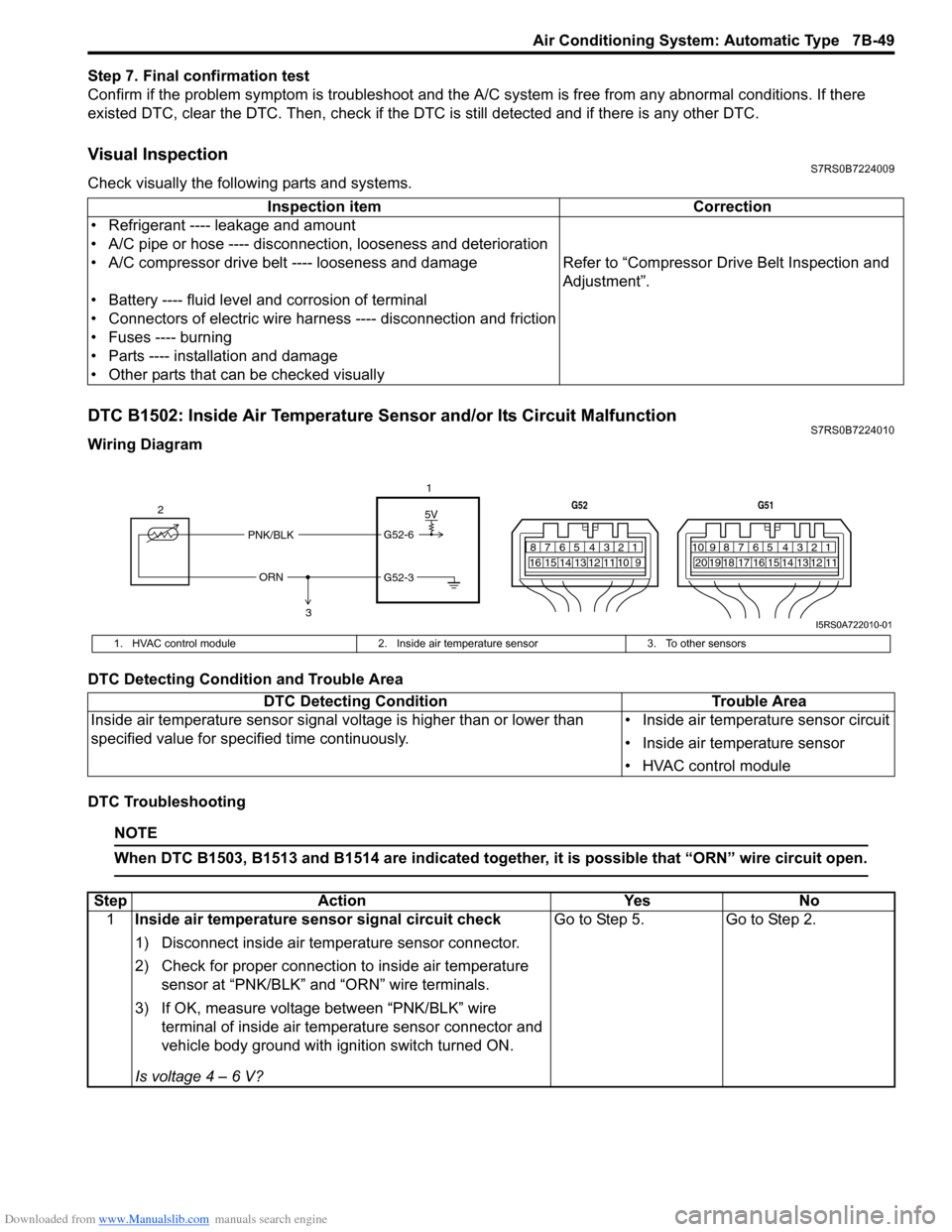
Downloaded from www.Manualslib.com manuals search engine Air Conditioning System: Automatic Type 7B-49
Step 7. Final confirmation test
Confirm if the problem symptom is troubleshoot and the A/C system is free from any abnormal conditions. If there
existed DTC, clear the DTC. Then , check if the DTC is still detected and if there is any other DTC.
Visual InspectionS7RS0B7224009
Check visually the following parts and systems.
DTC B1502: Inside Air Temperature Sensor and/or Its Circuit MalfunctionS7RS0B7224010
Wiring Diagram
DTC Detecting Condition and Trouble Area
DTC Troubleshooting
NOTE
When DTC B1503, B1513 and B1514 are indicated together, it is possible that тАЬORNтАЭ wire circuit open.
Inspection item Correction
тАв Refrigerant ---- leakage and amount
тАв A/C pipe or hose ---- disconnection, looseness and deterioration
тАв A/C compressor drive belt ---- looseness and damage Refer to тАЬCompressor Drive Belt Inspection and
AdjustmentтАЭ.
тАв Battery ---- fluid level and corrosion of terminal
тАв Connectors of electric wire harn ess ---- disconnection and friction
тАв Fuses ---- burning
тАв Parts ---- installation and damage
тАв Other parts that can be checked visually
5V
PNK/BLK
ORN G52-6
G52-3
2
1
3
7812910
65 431516 14 13 12 11
G52
789101920121112
65 431718 16 15 14 13
G51
I5RS0A722010-01
1. HVAC control module
2. Inside air temperature sensor 3. To other sensors
DTC Detecting Condition Trouble Area
Inside air temperature sensor signal voltage is higher than or lower than
specified value for specified time continuously. тАв Inside air temperature sensor circuit
тАв Inside air temperature sensor
тАв HVAC control module
Step
Action YesNo
1 Inside air temperature sensor signal circuit check
1) Disconnect inside air temperature sensor connector.
2) Check for proper connection to inside air temperature
sensor at тАЬPNK/BLKтАЭ and тАЬORNтАЭ wire terminals.
3) If OK, measure voltage between тАЬPNK/BLKтАЭ wire terminal of inside air temp erature sensor connector and
vehicle body ground with ignition switch turned ON.
Is voltage 4 тАУ 6 V? Go to Step 5.
Go to Step 2.
Page 1026 of 1496
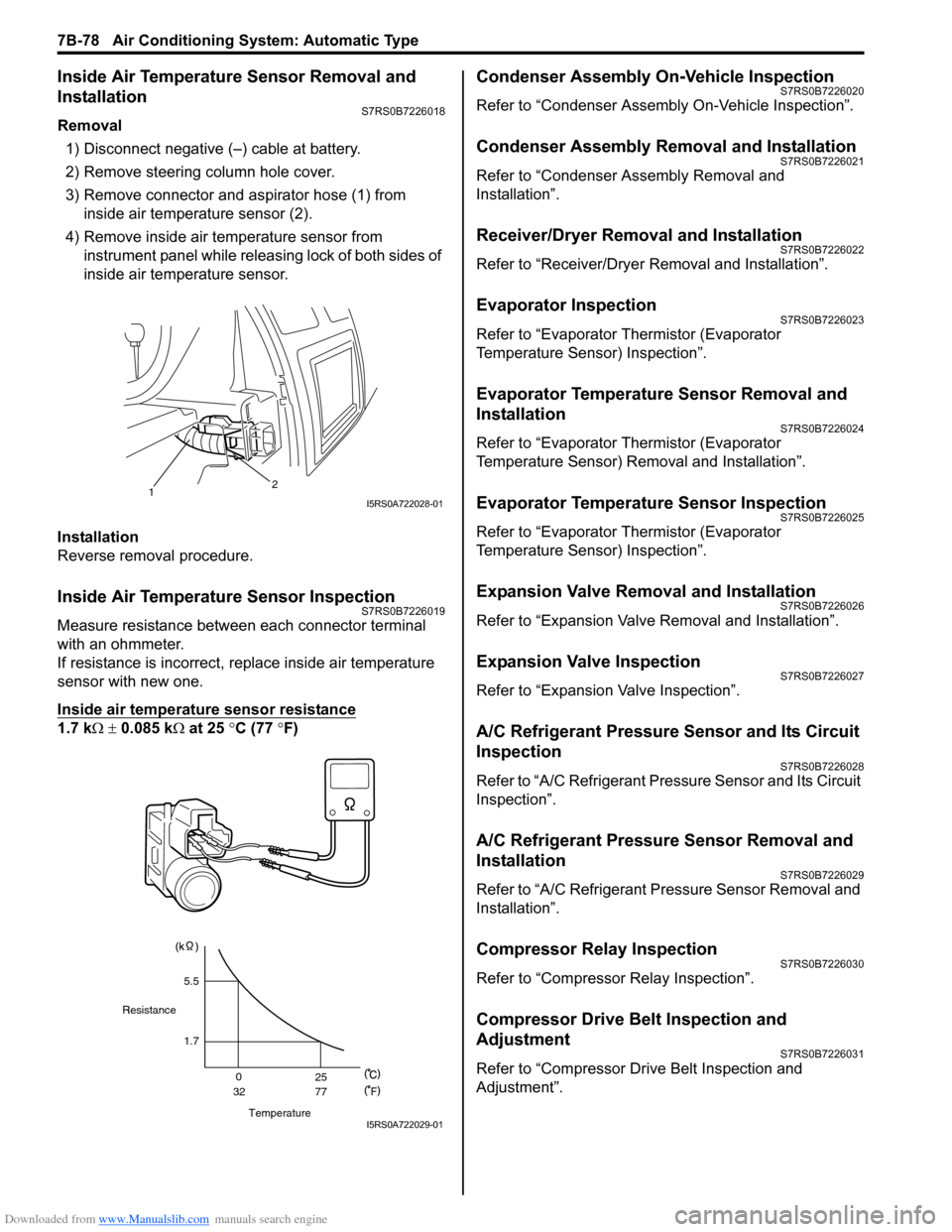
Downloaded from www.Manualslib.com manuals search engine 7B-78 Air Conditioning System: Automatic Type
Inside Air Temperature Sensor Removal and
Installation
S7RS0B7226018
Removal1) Disconnect negative (тАУ) cable at battery.
2) Remove steering column hole cover.
3) Remove connector and aspirator hose (1) from inside air temperature sensor (2).
4) Remove inside air temperature sensor from instrument panel while releas ing lock of both sides of
inside air temperature sensor.
Installation
Reverse removal procedure.
Inside Air Temperature Sensor InspectionS7RS0B7226019
Measure resistance between each connector terminal
with an ohmmeter.
If resistance is incorrect, replace inside air temperature
sensor with new one.
Inside air temperature sensor resistance
1.7 k тДж ┬▒ 0.085 k тДж at 25 ┬░C (77 ┬░ F)
Condenser Assembly On-Vehicle InspectionS7RS0B7226020
Refer to тАЬCondenser Assembly On-Vehicle InspectionтАЭ.
Condenser Assembly Removal and InstallationS7RS0B7226021
Refer to тАЬCondenser Assembly Removal and
InstallationтАЭ.
Receiver/Dryer Removal and InstallationS7RS0B7226022
Refer to тАЬReceiver/Dryer Removal and InstallationтАЭ.
Evaporator InspectionS7RS0B7226023
Refer to тАЬEvaporator Thermistor (Evaporator
Temperature Sensor) InspectionтАЭ.
Evaporator Temperature Sensor Removal and
Installation
S7RS0B7226024
Refer to тАЬEvaporator Thermistor (Evaporator
Temperature Sensor) Removal and InstallationтАЭ.
Evaporator Temperature Sensor InspectionS7RS0B7226025
Refer to тАЬEvaporator Thermistor (Evaporator
Temperature Sensor) InspectionтАЭ.
Expansion Valve Removal and InstallationS7RS0B7226026
Refer to тАЬExpansion Valve Removal and InstallationтАЭ.
Expansion Valve InspectionS7RS0B7226027
Refer to тАЬExpansion Valve InspectionтАЭ.
A/C Refrigerant Pressure Sensor and Its Circuit
Inspection
S7RS0B7226028
Refer to тАЬA/C Refrigerant Pressure Sensor and Its Circuit
InspectionтАЭ.
A/C Refrigerant Pressure Sensor Removal and
Installation
S7RS0B7226029
Refer to тАЬA/C Refrigerant Pressure Sensor Removal and
InstallationтАЭ.
Compressor Relay InspectionS7RS0B7226030
Refer to тАЬCompressor Relay InspectionтАЭ.
Compressor Drive Belt Inspection and
Adjustment
S7RS0B7226031
Refer to тАЬCompressor Drive Belt Inspection and
AdjustmentтАЭ.
12I5RS0A722028-01
Temperature
Resistance
1.7
0
32 25
77
F
5.5
I5RS0A722029-01
Page 1027 of 1496
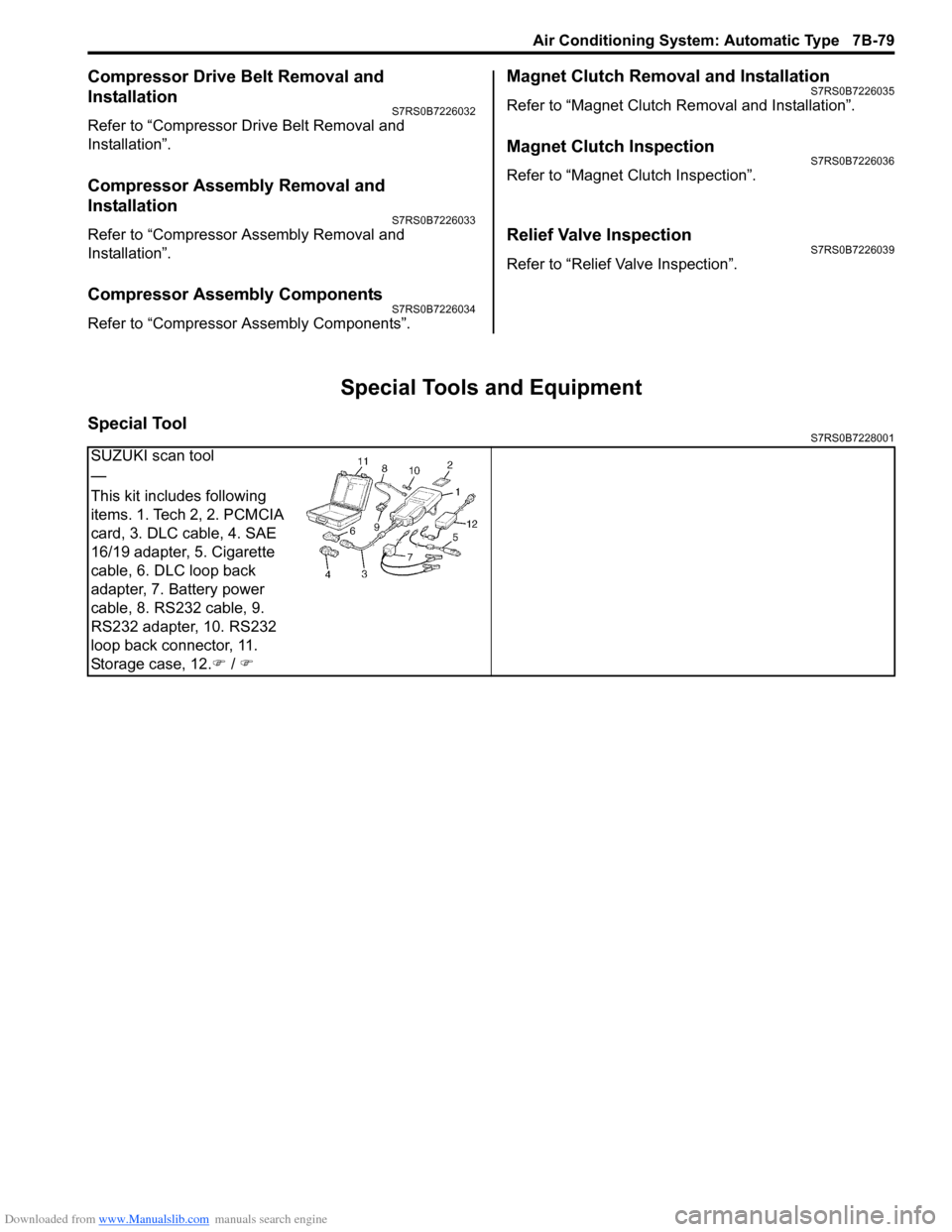
Downloaded from www.Manualslib.com manuals search engine Air Conditioning System: Automatic Type 7B-79
Compressor Drive Belt Removal and
Installation
S7RS0B7226032
Refer to тАЬCompressor Drive Belt Removal and
InstallationтАЭ.
Compressor Assembly Removal and
Installation
S7RS0B7226033
Refer to тАЬCompressor Assembly Removal and
InstallationтАЭ.
Compressor Assembly ComponentsS7RS0B7226034
Refer to тАЬCompressor Assembly ComponentsтАЭ.
Magnet Clutch Removal and InstallationS7RS0B7226035
Refer to тАЬMagnet Clutch Removal and InstallationтАЭ.
Magnet Clutch InspectionS7RS0B7226036
Refer to тАЬMagnet Clutch InspectionтАЭ.
Relief Valve InspectionS7RS0B7226039
Refer to тАЬRelief Valve InspectionтАЭ.
Special Tools and Equipment
Special ToolS7RS0B7228001
SUZUKI scan tool
тАФ
This kit includes following
items. 1. Tech 2, 2. PCMCIA
card, 3. DLC cable, 4. SAE
16/19 adapter, 5. Cigarette
cable, 6. DLC loop back
adapter, 7. Battery power
cable, 8. RS232 cable, 9.
RS232 adapter, 10. RS232
loop back connector, 11.
Storage case, 12.�) / �)
Page 1405 of 1496
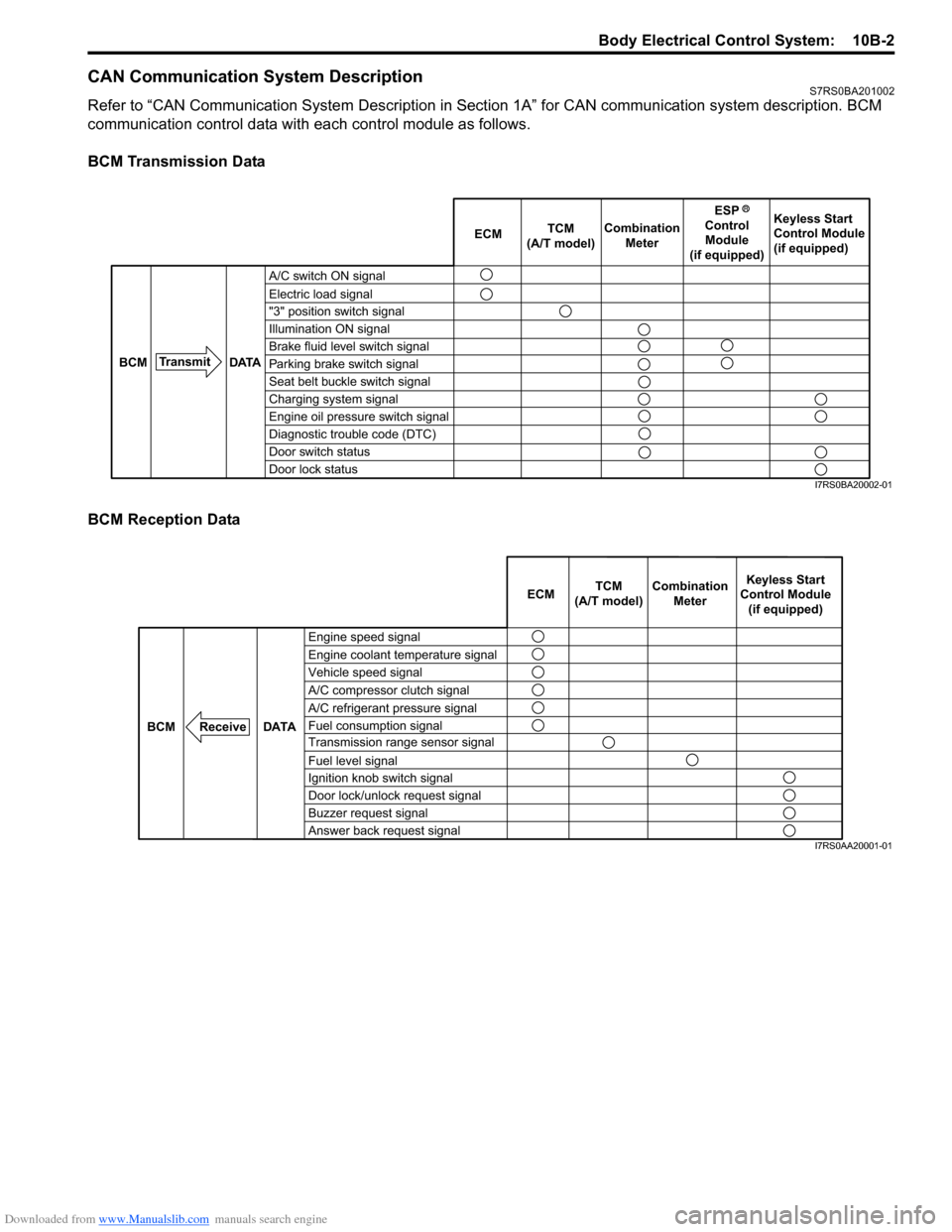
Downloaded from www.Manualslib.com manuals search engine Body Electrical Control System: 10B-2
CAN Communication System DescriptionS7RS0BA201002
Refer to тАЬCAN Communication System Description in Section 1AтАЭ for CAN communication system description. BCM
communication control data with ea ch control module as follows.
BCM Transmission Data
BCM Reception Data
A/C switch ON signal
Electric load signal
"3" position switch signal
Illumination ON signal
Brake fluid level switch signal
Parking brake switch signal
Seat belt buckle switch signal
Charging system signal
Engine oil pressure switch signal
Diagnostic trouble code (DTC)
Door switch status
Door lock status ECM
TCM
(A/T model) Combination
Meter Keyless Start
Control Module
(if equipped)
Transmit DATA
BCM
ESP
Control Module
(if equipped)
I7RS0BA20002-01
Engine speed signal
Vehicle speed signal Engine coolant temperature signal
A/C refrigerant pressure signal
Fuel consumption signal A/C compressor clutch signal
Transmission range sensor signal
Fuel level signal
Ignition knob switch signal
Door lock/unlock request signal
Buzzer request signal
Answer back request signal
DATA
BCM
Receive
Combination
Meter
TCM
(A/T model) Keyless Start
Control Module (if equipped)
ECM
I7RS0AA20001-01